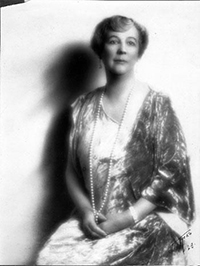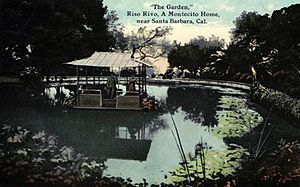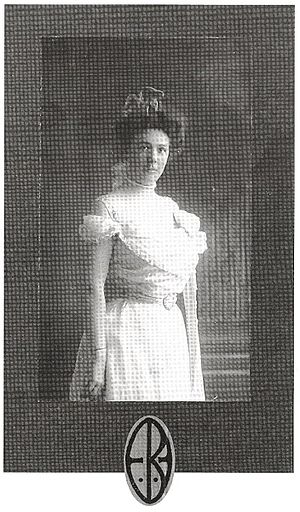Elizabeth Eaton Burton facts for kids
Quick facts for kids
Elizabeth Eaton Burton
|
|
|---|---|
 |
|
| Born | 1869 Paris, France
|
| Died | 1937 Los Angeles, California
|
| Nationality | American |
| Known for | design |
| Movement | Arts and Crafts |
| Spouse(s) | William W. "Billy" Burton |
Elizabeth Eaton Burton (born 1869, died 1937) was an American artist. She was also a designer. Her art showed the style of the Arts and Crafts movement in southern California.
Elizabeth's Early Life
Elizabeth was born in Paris, France, in 1869. Her parents were Charles Frederick Eaton and Helen Justice Mitchell. Her father was an artist and designer. He worked with materials like metal, glass, and leather. He taught Elizabeth how to draw. He also taught her the basics of other art forms. This was almost all the art training she ever had.
In 1885 and 1886, she went to boarding schools in England and Germany. Both Elizabeth and her mother had health problems. Because of this, the family moved to Nice, France. When Elizabeth was about 17, they moved to the United States. They settled near Santa Barbara, California.
Her father, Charles Eaton, became a landscape architect. He designed outdoor spaces. The house he built for his family was called Riso Rivo. It was in Montecito. The house had a lotus pond and a Japanese teahouse. Elizabeth kept a detailed scrapbook. In it, she described life in southern California. She found it "primitive" at first. This was compared to her family's city life before.
In 1893, Elizabeth married William W. "Billy" Burton. He worked in real estate. They had a son named Phillip and a daughter named Helen.
Elizabeth's Art Career
Elizabeth Burton started her career by showing her art. She displayed her work at art shows and craft fairs. These events were held in southern California. As she grew as an artist, she worked with more materials. She created metalwork, stained glass, and bookbinding. She also made tooled leather items. She used printmaking (woodcuts) and watercolor painting too.
Many of her artworks feature flowers. You can also see a clear influence from Asian art. This is true for both her style and her subjects. It is especially clear in her prints. Some of her lamps are good examples of her Arts and Crafts style. They are made of copper and shaped like abstract flowers. They have abalone shells as the lamp shades. Other lamps had plant designs. These were made using a technique called repoussé. This means shaping metal by hammering it from the back. One of Burton's fountains is in the lobby of the Mammoth Hotel. This hotel is in Yellowstone National Park. The fountain is made of copper and has koi fish designs.
In 1896, Burton opened her own art studio. It was located in Santa Barbara. She focused on decorative items. These were made from metal, leather, and shell. As the new century began, she showed her art across the country. In 1904, she and her father both showed art at the St. Louis World's Fair. Elizabeth displayed leatherwork. It had shells or silver leaf decorations.
She received a special legal right for a technique she created. This technique used ornamental leatherwork on furniture and screens. Her leather screens were praised by Gustav Stickley. He had a very important magazine called The Craftsman.
In 1909, Burton moved her family to Los Angeles. She opened a studio in the Blanchard Building. That same year, she won a medal. This was at the Alaska-Yukon-Pacific Exposition in Seattle. Both she and her father showed their art at this event.
In 1920, Burton's husband died. He had a heart attack. After this, she went on a two-year trip around the world. She stopped in Paris for advanced art training. She also spent time in Brittany, France, painting local scenes. When she came back to Los Angeles, she published a book. It was about her travels and was called Paris Vignettes (1928).
In the 1920s, Burton worked to promote French culture and art in California. For her efforts, the French government gave her an award. It was called the Palme Academique in 1929.
In 1930, her father passed away. Burton then spent two more years in France. After that, she traveled to China and Japan. She painted watercolors and studied woodblock printing there. A publisher in Tokyo, Kato Junji, made some of her watercolors into woodblock prints. These prints became part of a traveling art show. It went around the world in 1935 and 1936. It stopped in cities like Beijing, Shanghai, Tokyo, Los Angeles, and New York.
Elizabeth Burton died in Los Angeles on November 15, 1937.
See also
 In Spanish: Elizabeth Eaton Burton para niños
In Spanish: Elizabeth Eaton Burton para niños



